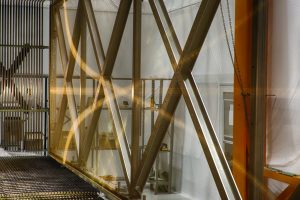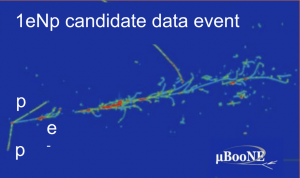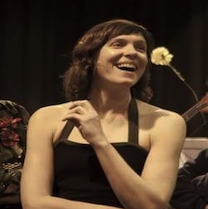- Jan. 15, 2023, 2:00 pm US/Central
- Suzie Shrubb, 2022 Guest Composer
- Tickets: Free but registration required
- Purchase tickets »
This event will be presented via the Zoom platform. Free registration is available in advance.
“Throughout my residency I have been resident in MicroBooNE, collaborating closely with physicists. From this rich dialogue and research between our modalities an entire body of work, ‘Cross Sections’ has emerged. Cross sections are a type of measurement made at MicoBooNE and each movement of my piece ‘Cross Sections’ focuses on the music of the way these measurements are made at each stage of the process, ranging from the music of the detector (a type of musical instrument I call a particlellophone), the particles themselves, and the interaction of the particles with the detector through to the music of the data gathered, to interpreting the event displays and the data that creates them as musical scores and therefore literally reconstructing these interaction events in sound vibrations. Intertwined with this music of the atoms is the music that emerges when we apply concepts from the physics to musical structures and systems such as “decay”, or “resonance”. Running through ‘Cross Sections’ is a narrative thread that follows the physicists experimental journey. The opening movements of ‘Cross Sections’ focus on the stages of gathering data, the detector and particles interactions, and as we move through, the pieces become more focussed on the data and directly translating the music of the data with exact precision before the final piece which is the cross section measurement itself. The three pieces you will experience at the premier each represent a different piece from this body of works that gives a sense of the trajectory and ideas. It has been and continues to be an enormous honour to work with these people and I am full of deep gratitude to them for coming with me on the journey to create, and explore and research and express these pieces. I am thrilled to be bringing these pieces out into the wider world and look forward to sharing them with you at this premier.”
In this piece we take the ideas that we’ve explored in the world of particle physics and apply them to explore the world of music. We enter into an imaginative space and turn the piano into a detector and experience it’s sounds and tones and resonances. Another way to think of this piece (with thanks to Mateus Carniero) is that we are making music with the physics as we build sound worlds that increase and nurture the resonances of the harmonic series as expressed by the pianos as they vibrate, interact, amplify, and diminish.
More about Suzie (from FermiNews)
Suzie Shrubb draws musical inspiration from the cosmos at large
As a musician, Suzie Shrubb has always looked up to the skies for inspiration. The music of the universe and its particles has always fascinated them, which is why their appointment as the U.S. Department of Energy’s Fermi National Accelerator Laboratory’s guest composer this year makes perfect sense.
Based in the United Kingdom, Shrubb, who uses both they/them and she/her as pronouns, is a composer as well as a classical and improvising musician who plays the piano and the oboe. They currently work with the Hurly Burly Theatre in the UK. Their previous collaborations have included work as a resident artist with the Oxford Playhouse, Lancaster University and Royal Opera House, among others.
Now in its third year, Fermilab’s guest composer program fosters the relationship and engagement between scientists, composers and the public. According to Shrubb, their yearlong online residency at Fermilab is a chance to musically express the energy and sounds of the science at the lab. From conversations with physicists to the specific noises of technology in experiments, these sounds and experiences all will inspire her body of work, which will be presented to the community at the end of the residency.
In some ways, her appointment at Fermilab is the culmination of two lifelong passions – music and physics. Shrubb has been a musician their whole life and started playing piano as a toddler.
“When I was a child, all of the Voyager and Pioneer data started coming back. I was fascinated by that,” said Shrubb. “Also, my mother would teach me all the constellations at night when I couldn’t sleep. So, I was very lucky in that respect; these ideas were always wafting around in my life.”
Shrubb said that at a certain point they just started to think of music and physics as one in the same. They drew inspiration from various ideas: the ancient Greek concept of music of the spheres (the idea that the movements of celestial bodies, such as the sun, the moon and the planets, are a form of music), great cosmic fugues, and various cosmologies of gods singing the cosmos into being.
“I feel like a musical space is a context through which we can take these particle physics systems that are a description of a reality and then translate them. It’s an expression and a relationship,” said Shrubb.
Shrubb has previously been a guest speaker for VOICES, or Virtual Ongoing Interdisciplinary Collaborations on Educating with Song, to share their work on translating neutrino oscillations into musical notation. At Fermilab, they have already begun talking to physicists about using experimental data for composition. Even though Shrubb does not have a particle physics academic background, she hopes that by engaging in dialogue with various Fermilab scientists, she can create pieces of music that are very specific to their field of research or work.
For instance, Shrubb is taking the mapped movement of a proton going through a detector to create a musical score that illustrates the proton’s journey. To do so, she first converts the mass or energy of the quarks that make up the proton into hertz and then translates that into scientific pitch notation, which can be played on any musical instrument. But as Shrubb pointed out, the science can inspire multiple different approaches and interpretations, including improvisation.
“The proton just becomes a set of instructions for our musicians. We all begin here, and we all know we’re going to end there. The piece is us going on this journey to find that beginning and ending place,” they said. “Working within the constraints of the journey, musicians can then improvise how they end up from start to finish.”
“I feel like a musical space is a context through which we can take these particle physics systems that are a description of a reality and then translate them.” — Suzie Shrubb, Fermilab 2022 guest composer
Shrubb noted that this interpretation may not necessarily speak to the truth of what’s going on with the particles. In order to reflect that, they are going to translate the data of the image to map the different energy levels to different pitches and notes.
“Suzie’s deep passion for, and prior experience in, melding physics and music composition made her a natural fit for this Fermilab adventure. Collaboration is such a huge part of Suzie’s music-making, working with various volunteer choirs and other groups, even through COVID,” said Janet MacKay-Galbraith, who manages Fermilab’s guest composer program, which explores the relationship between art and science.
“In fact, Suzie had already worked with [Fermilab scientist] Elena Gramellini, providing a musical backdrop for Elena’s 2021 Physics Slam film, before even starting their residency.”
Pulling from their previous work, Shrubb hopes to eventually run improvisation sessions for anyone musically inclined at Fermilab, so that people can gather and bounce ideas back and forth to create music together. They also plan to give a talk during their residency, explaining their process behind translating scientific data into music.
“They bring great enthusiasm to our guest composer program and is a terrific representative of the relationship between art/music and science,” added MacKay-Galbraith.
Fermi National Accelerator Laboratory is supported by the Office of Science of the U.S. Department of Energy. The Office of Science is the single largest supporter of basic research in the physical sciences in the United States and is working to address some of the most pressing challenges of our time. For more information, please visit science.energy.gov.







